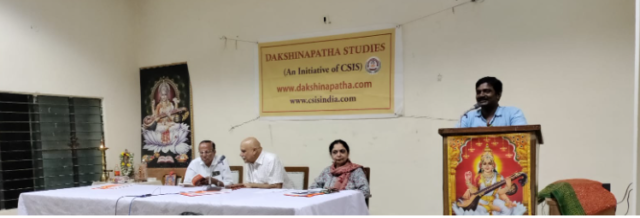
Dakshinapatha Studies – Talk Series (12th Aug 2023)
Center for South Indian Studies, Dakshinapatha
Center for South Indian Studies, Dakshinapatha
In commemoration of the coronation event of Musunuri Nayaka Kings to the throne nearly seven centuries ago ( the date of coronation estimated to be 13th August), and in view of the forthcoming 77th Independence Day celebrations on 15th Aug 2023, Dakshinapatha Studies organized the important talk on ‘Wars and icons’ from the Telugu region, as part of the Dakshina Bharatha lecture series.
Eminent historians, authors and speakers – Prof Dr Anjaiah, retd HoD, History dept, Osmania University & Prof Dr Rahul Shastri, retd professor, Economics, Osmania University – delivered the important keynote addresses in the program held on the evening of 12th Aug 2023 at Surabharathi auditorium, Osmania University campus.
Prof Dr Anjaiah stated that Prataparudra II was the last ruler of kakateeyas, it was a challenging period as Yadavas, Pandyas, Hoyasalas etc continued to fight internecine battles, this disunity provided a golden opportunity for the Delhi sultanate to penetrate into Dakshina Bharatha.
Vilasa sasanam, Kalvacheruvu sasanams which were unearthed, provide detailed descriptions of cultural invasions and large-scale destruction and killings caused by Delhi sultans, the ultimate aim was to convert the country into dar-ul-islam. Treacherous acts by Delhi sultanate forced the mighty Prataparudra II to come out of the fort in 1323 CE, he lost in the ensuing war. Prataparudra Charitra by Pandit Ekamranatha gives the details of the destruction, plunder and killings in the countryside during that tragic period. Prataparudra’s efforts and war campaigns were detailed by Prof Parabrahma Shastry, in a historical volume published by Govt of AP in 1976. Cynthia Talbot in her work praised Prataparudra II. Several scholars including Prof Velcheru Narayana Rao give the entire descriptions of the last ruler of the Kakateeyas. As we are aware, Prataparudra ended his life in the Narmada river enroute to Delhi when he was held captive. However the resistance never died down, Harihara I and Bukka I came back from Delhi and mounted a systematic attack against Delhi sultans.
Historian and author Prof Dr Rahul Shastri in his address described the new and pioneering pieces of evidence he gathered in his research in piecing together the Telugu history of the region. He stated that the nature of British Colonialism cannot be understood unless we understand the Shia-Sunni conflicts. Shias captured Iran in 1500 CE and Bijapur sultans proclaimed themselves as Shia. In order to Islamize the Hindu society, they imported shias from Persia, who looted the wealth and returned to Iran, some have defected to Mughals. They were more shia-sunni conflicts, than Hindus-muslim conflicts during that period. Tanisha came to power, the efficient prime minister Madanna, through his administration provided the succour to the masses, and somewhat alienated the Hindu zamindars. He also tried to unite Hindus and Muslims against the foreign plunderers – Pathans, Afghans, afaki Persians. Chattrapati Shivaji was coordinating with Ministers Akkanna and Madanna, they received Shivaji Maharaj and mediated an understanding between Tanisha and Shivaji. Tanisha helped Shivaji to recapture kingdoms in South. However when the tribute wasn’t paid by the Tanisha, the relationship soured. In 1647, Akkanna and Madanna were beheaded by the invading armies of Aurangzeb. During this barbaric period of invasions, hundreds of Dakhani Brahmins were killed right upto Masulipatnam on the east coast. Moru & Ramdas headed the prolonged battles which included the Brahmin rebellion against the Muslim state. It is said that the rebellion continued upto 100 years thereafter. Aurangzeb maintained pandit-khanas specially to imprison Brahmins. Speaking about the ‘Anti-british conspiracy of Deccan’, Dr Shastri recounted the new historical evidence of the famed Raja Mahipat Ram who headed the Deccan army, he became the Commanding General against British army. The heroic exploits of Raja Mahipat Ram who belonged to the Brahma-kshatriya samaj are many, he won many battles. However the pro-british faction became powerful later and Hyderabad became the first vassal state of the British. Unknown to the enemy, Raja Mahipat Ram started to ally with Marathas against the British. Mahipat Ram created confusion in the ranks, much later he was made Governor of Berar. Mir Alam and Chandulal led the anti-british battle. Later Mahipat Ram was banished to Sagar in Central India, though army troupes supported him. These events led to the Sholapur Revolt on 10th Feb 1808, the heroic Inkuppa Nayak led the battle. Unfortunately Raja Mahipat Ram was killed in suspicious circumstances in Indore later. Raja Mahipat Ram came to be known as the first independence fighter and a road near Koti in Hyderabad was named after him during the 1970s. However the name disappeared later. Dr Rahul Shastri in his very informative talk gave rich details of the long period of nizams.
An interesting and stimulating question & answer session continued for a long time with the audience asking several questions to both the learned speakers. Ms Shailaja from CSIS anchored during the evening’s program.














